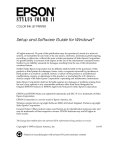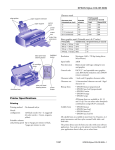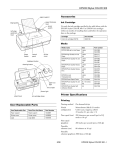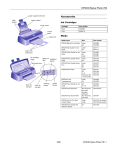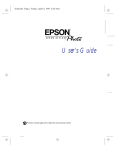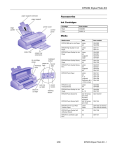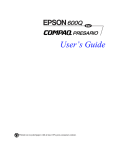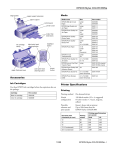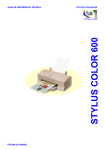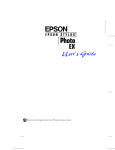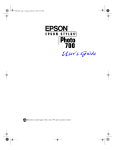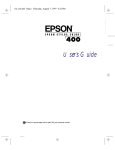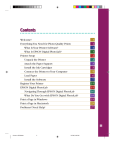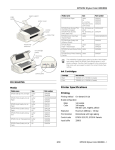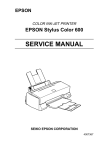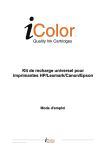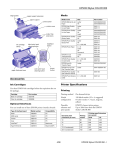Download Epson Stylus Photo Ink Jet Printer Product Information Guide
Transcript
EPSON Stylus Photo Nozzle configuration paper support extension edge guides 32 nozzles × 6 (black, cyan, magenta, yellow, light cyan, light magenta) paper support Printable columns and printing speeds printer cover 20 inches per second (printable area 8.26 inches) control panel output tray Print quality Available dots 180 dpi 1488 360 dpi 2976 720 dpi 5952 Resolution Maximum 720 dpi × 720 dpi Print direction output tray extensions Bidirectional with logic seeking Control code ink cartridge clamp paper light ESC/P Raster ™ load/eject button Line spacing thickness lever 1/6 inch, programmable in 1/360-inch increments Paper feed speed 66.6 milliseconds per 1/6-inch line Input buffer 64KB black ink out light color ink out light cleaning button Character tables power button The characters for PC437 (US, Standard Europe) and PC850 (Multilingual) can be selected using the following procedure: P R When the printer is off, hold down the cleaning button power button. Then release both buttons. and press the This changes the character table to PC850. Repeat the procedure to change it back to PC437. You can run a printer check as described on page 5 to verify the current character table. Printer Specifications Printing Printing method EPSON’s exclusive drop-on-demand Micro Piezo ink jet technology 3/97 EPSON Stylus Photo - 1 EPSON Stylus Photo Paper Paper type Size Paper types Thickness Weight Single sheets Letter (8.5 × 11 inches) Legal (8.5 × 14 inches) Statement (5.5 × 8.5 inches) Executive (7.5 × 10 inches) A4 (210 × 297 mm) A5 (148 × 210 mm) B5 (182 × 257 mm) Plain bond paper and special ink jet papers distributed by EPSON 0.003 to 0.004 inch (0.08 to 0.11 mm) 17 to 24 lb (64 to 90 g/m2) Transparencies, Glossy film, Glossy paper Letter (8.5 × 11 inches) A4 (210 × 297 mm) A6 (105 × 148 mm, glossy film only) Photo paper (4 × 6 inches) Transparencies, glossy paper, and glossy film distributed by EPSON Adhesive sheets A4 (210 × 297 mm) Self adhesive sheets distributed by EPSON Envelopes No. 10 0.006 to 0.017 inch (0.16 to 0.43 mm) 12 to 20 lb (45 to 75 g/m2) DL C6 Index cards 9.5 × 4.1 inches (240 × 104 mm) 8.7 × 4.3 inches (220 × 110 mm) 4.4 × 6.4 inches (114 × 162 mm) A6 (105 × 148 mm) 5 × 8 inches (127 × 203 mm) 10 × 8 inches (254 × 203 mm) Plain bond paper or air mail paper Ink jet cards distributed by EPSON Note: Since the quality of any particular brand or type of paper may be changed by the manufacturer at any time, EPSON cannot attest to the quality of any non-EPSON brand or type of paper. Always test samples of paper stock before purchasing large quantities or printing large jobs. Poor quality paper may reduce print quality and cause paper jams and other problems. If you encounter problems, switch to a higher grade of paper. Do not load curled or folded paper. EPSON ink jet papers and other special media are only usable under normal conditions: Temperature: 59 to 77°F (15 to 25°C) Humidity: 40 to 60% RH Printouts on EPSON Photo Quality Glossy Film should be stored under the following conditions: Temperature: 59 to 86°F (15 to 30°C) Humidity: 20 to 60% RH 2 - EPSON Stylus Photo 3/97 EPSON Stylus Photo Printable area A A B-L B-R B-L B-R C C Single sheet A: Envelope The minimum top margin is 0.12 inch (3.0 mm). Note: Always load paper into the sheet feeder short edge first. However, envelopes should be loaded long edge first. When loading multiple sheets of EPSON Photo Quality Glossy Film, the minimum top margin is 1.2 inches (30 mm). B: The minimum left margin is 0.12 inch (3.0 mm). The minimum right margin for letter and legal size paper is 0.35 inch (9.0 mm). The minimum right margin for other sizes of paper is 0.12 inch (3.0 mm). The minimum right margin for envelopes is as follows: 0.28 inch (7 mm) for DL envelopes. 1.10 inches (28 mm) for No. 10 envelopes. 0.12 inch (3 mm) for C6 envelopes. C: The minimum bottom margin is 0.54 inch (14.0 mm). Ink Cartridge Specification Black ink cartridge (S020093) Color ink cartridge (S020110) Color(s) Black Cyan, Magenta, Yellow, Light Magenta, Light Cyan Print capacity* 540 pages/A4 (ISO/IEC 10561 Letter Pattern at 360 dpi) 190 pages (A4, 360 dpi, 5% duty each color) Cartridge life 2 years from production date (if unopened) (within 6 months after opening package, at 77 °F (25 °C)) Storage temperature –4 to 104 °F (–20 to 40 °C) 1 month at 104 °F (40 °C) Transit temperature –22 to 140 °F (–30 to 60 °C) 1 month at 104 °F (40 °C) 120 hours at 140 °F (60 °C) Freezing temperature** 3.2 °F (–16 °C) –0.4 °F (–18 °C) Dimensions 0.7 (W) × 2.1(D) × 1.5 (H) inches 19.8 (W) × 52.7(D) × 38.5 (H) mm 2.0 (W) × 2.1(D) × 1.5 (H) inches 51.4 (W) × 52.7 (D) × 38.5 (H) mm * The print capacity may vary, depending on how often you use the print head cleaning function. ** It thaws and is usable after approximately 3 hours at 77 °F (25 °C). Caution: To ensure good results, use genuine EPSON ink cartridges. Other products may cause damage to your printer not covered by EPSON’s warranty. Don’t use an ink cartridge if the date on the package has expired. 3/97 EPSON Stylus Photo - 3 EPSON Stylus Photo Mechanical Humidity Paper feed method Operation: Storage: Friction Paper path 20 to 80% RH (without condensation) 5 to 85% RH (stored in shipping container, without condensation) Safety Approvals Sheet feeder, rear entry Safety standards Sheet feeder capacity UL 1950 with D3, CSA C22.2 No.950 with D3 100 sheets at 17 lb (64 g/m2) paper EMC Dimensions FCC part 15 subpart B class B, CSA C108.8 class B Storage Width: Depth: Height: Interface 16.9 inches (429 mm) 10.8 inches (275 mm) 6.6 inches (168 mm) Your printer is equipped with an 8-bit parallel interface and a Macintosh® serial interface. Printing Parallel interface Width: Depth: 16.9 inches (429 mm) 24.1 inches (613 mm) 27.4 inches (695 mm) when printing transparencies 12.2 inches (309 mm) 7.7 inches (196 mm) when printing transparencies Height: The built-in parallel interface has the following characteristics: Forward channel Data format: 8-bit parallel, IEEE-1284 compatibility mode Synchronization: STROBE pulse Handshake timing: BUSY and ACKNLG signals Weight Signal level: TTL compatible 11.5 pounds (5.2 kg) without the ink cartridges Connector: 57-30360 Amphenol connector or equivalent Electrical Reverse channel Specification Input voltage range 120V Model 220-240V Model 103.5 to 132V 198 to 264V Rated frequency range Adaptable connector: 57-30360 Amphenol Connector or equivalent 50 to 60 Hz Input frequency range 49.5 to 60.5 Hz Rated current Power consumption Transmission mode: IEEE-1284 Nibble mode 0.4A Synchronization: Refer to the IEEE-1284 specification 0.2A Handshaking: Refer to the IEEE-1284 specification Approx. 15W (ISO/IEC 10561 Letter Pattern) Signal level: IEEE-1284 Level 1 device Note: Check the label on the back of the printer for the voltage rating of your printer. Data transmission timing: Refer to the IEEE-1284 specification Serial interface The printer’s built-in serial interface is based on the RS-423 standard. This interface has the following characteristics: Environmental Temperature Operation: Storage: Standard: Based on RS-423 50 to 95 °F (10 to 35 °C) –4 to 140 °F (–20 to 60 °C), stored in shipping container 1 month at 104 °F (40 °C) 120 hours at 140 °F (60 °C) 4 - EPSON Stylus Photo Synchronization: Synchronous Bit rate: Approx. 900 Kbps Handshaking: X-ON/X-OFF, DTR protocol 3/97 EPSON Stylus Photo Word format: The four lights on your printer’s control panel show the printer’s status and alert you to problems like paper jams. Data bit: 8 bits Parity bit: None Start bit: 1 bit Stop bit: 1 bit S Connector: 8-pin mini-circular connector BA BA Recommended cable: Apple System Peripheral-8 cable Initialization The printer can be initialized (returned to a fixed set of conditions) in these ways: Hardware initialization ∗ The printer is turned on. ∗ The printer receives an INIT signal from the interface. Software initialization ∗ Software sends the ESC @ (initialize the printer) command. SBA parallel P Hardware initialization When the printer is turned on, the printer mechanism is initialized, the input and print buffers are cleared, and all settings return to their default values. However, the printer mechanism is not initialized if the printer is turned on within 10 seconds after being turned off. In this case, the printer caps the print head, and ejects any paper in the paper path. PSBA PSBA Software initialization Software initialization clears the print buffer and returns all settings to their default values. However, software initialization does not initialize the printer mechanism or clear the data buffer. When the paper light comes on, your paper ran out or is incorrectly loaded. Load paper in the feeder and then press the load/eject button. E When an ink light comes on, you need to replace the ink cartridge. When an ink light flashes, your ink supply is low. Make sure you have a replacement cartridge. When the paper light flashes and the ink out lights are on, you have a paper jam. Turn off the printer and gently pull out all jammed paper. Then press the load/eject button. E The power light is on when the printer is on. The power light flashes when the printer is receiving a print job or performing a maintenance operation. When the power and paper lights flash and the ink out lights are on, your printer has a button twice to carriage error. Press the reset the printer. P When all the lights flash, your printer may have an internal error. Running a Printer Check You can run a printer check to determine whether a problem comes from the printer itself or some other source. Control Panel ❏ If the results are satisfactory, the problem lies in software settings, the interface cable, or your computer. power light paper light ❏ If the printer check does not print correctly, you have a problem with your printer. black ink out light Follow these steps to check the printer: 1. Make sure both the printer and computer are turned off. 2. Disconnect the interface cable from the printer. 3. Make sure paper is loaded in the printer. color ink out light cleaning button load/eject button E P P 4. Hold down the load/eject button and press the power button. Hold down the buttons until the power light starts to flash. Then release both buttons. power button The printer prints one page containing a nozzle check pattern, the printer’s ROM version, ink counter code, and character table. 3/97 EPSON Stylus Photo - 5 EPSON Stylus Photo You see the Spool Manager window: 5. After it prints the page, turn off the printer. Remember to reconnect the interface cable, then turn on the printer and your computer. menus queue journal file Managing Print Jobs in Windows Your Windows® printer software includes two management utilities: the Spool Manager and Status Monitor. ❏ The Spool Manager starts automatically when you send a job to the printer. It allows you to print in the background while you continue to work on your computer and to hold jobs to print at a later time. If you’re using your printer on a network, it also handles multiple print jobs. The Spool Manager window displays the status of your print queues and journal files and lets you control them. Here are some of the things you can do: ❏ Hold or release a queue ❏ The Status Monitor, which is available only if you’re using Windows 95, also starts automatically when you send a job to the printer. It displays on your screen to alert you about printer and ink status. ❏ Send journal files to your printer over a network ❏ Hold, re-queue, or delete a journal file ❏ Select the information you want to see in the Spool Manager window Note: The Status Monitor doesn’t appear if you’re printing over a network. ❏ Prevent the Despooler popup window from appearing on your screen whenever you print ❏ Change your default spool directory Tip: For information about any of these procedures, use the Spool Manager Help menu. Using the Spool Manager The Spool Manager works like the Windows Print Manager. When you send a job to your printer, your printer software creates a temporary journal file, stores it in the C:\TEMP or C:\WINDOWS\TEMP folder or directory, and assigns it to a print queue. The software then sends the file to your printer at the right time. Using the Status Monitor The Status Monitor, available only if you’re using Windows 95, displays automatically when you send a job to the printer. However, you can use it at any time to see how much ink you have left. Follow these steps: ❏ To open the Spool Manager while you’re printing, click the Spool Manager icon that appears on the Taskbar (Windows 95) or at the bottom of your desktop (Windows 3.1). 1. Access the Main printer settings dialog box. 2. Click the Utility tab. ❏ To open it at any time, double-click the Spool Manager4 icon in the EPSON program group or folder. Note: In Windows 3.1, you may not see the Spool Manager icon if the Program Manager or current window is maximized. Make the window smaller to see the Spool Manager icon. 6 - EPSON Stylus Photo 3/97 EPSON Stylus Photo ❏ The Status Monitor alerts you to any problems that occur during printing. You can also use it at any time to see how much ink you have left. You see the Utility menu: Using Monitor2 The Monitor2 utility lets you continue to work on your Macintosh while your document is printing. However, background printing is slower and may also slow down your system. If you want to use this utility, you need to turn on background printing in the Chooser and increase the memory allocation for Monitor2. Follow these steps: 1. Open the Chooser from the Apple menu and select the EPSON Stylus(EX) icon. Then click either the printer or modem icon. 2. Under Background Printing, click On and close the Chooser. 3. Click the EPSON Status Monitor icon.You see the Despooler window with the Status Monitor at the bottom. 3. To increase the memory allocated to Monitor2, select EPSON Monitor2 in the Extensions folder in your System folder. 4. Choose Get Info from the File menu. 5. Under Memory Requirements, set the Prefered Size to 3000K. 6. While you’re printing, click the EPSON Monitor2 icon on the Application menu at the right end of the menu bar. You see a dialog box like the following: job currently printing jobs queued for printing appear here 4. Check the amount of ink you have left. Managing Print Jobs on a Macintosh Your Macintosh printer software includes two management utilities: Monitor2 and Status Monitor. 7. You can select a job and cancel it or just use this window to track the printer’s progress. ❏ If you’re using background printing, Monitor2 starts automatically when you send a job to the printer. It handles printing while you continue to work on your Macintosh and lets you track documents that are waiting to be printed. 3/97 EPSON Stylus Photo - 7 EPSON Stylus Photo Using the Macintosh Status Monitor You can use the Status Monitor to check the level of ink in your printer and to control the way your software warns you about printer problems. Follow these steps: 1. Choose Print from the File menu or click the print icon in your application. You see the printer settings dialog box. 2. Click the Utility button. 8 - EPSON Stylus Photo 3/97 EPSON Stylus Photo You see the Utility menu: Network Printing on a PC You can use your printer on a network under Windows 95 or other network operating systems. The Spool Manager sends journal files from your computer to a shared directory on a network server. These files can then be printed from another computer attached to the printer. First you need to install the EPSON Stylus Photo printer software on each computer that is going to print on the network. Then run Spool Manager and identify the shared directory to use for journal files. After you set this up on the system connected to the printer (the host system), you need to perform a similar procedure on each remote system on the network. 3. Click the Status Monitor icon. The software checks the amount of ink remaining in the printer and displays the Status Monitor window: Under Windows 95, you also need to specify the port and network path to the printer. Setting Up the Host System Follow these steps to set up the computer connected to the printer: 1. Create an icon for the EPSON Spool Manager (EPSPMGR4.EXE) in the \WINDOWS\SYSTEM folder. 2. Place this icon in the Startup folder. 3. Open the Spool Manager window as described on page 6. 4. In the Spool Manager window, double-click the queue you want to use for network printing. The Queue Setup dialog box appears. 5. Click the Remote Despool tab and then click the Printing from remote queues option. Click to control messages and warnings 6. Click the Browse button and select the remote server directory that will receive journal files. Click to recheck ink level 7. Click OK and minimize the Spool Manager. 4. If you want to change printer messages and warnings, click the Configuration button. Setting Up Remote Systems Follow these steps to set up computers on the network: You see the following dialog box: 1. Create an icon for the EPSON Spool Manager (EPSPMGR4.EXE) in the \WINDOWS\SYSTEM folder. Printing stops when these messages appear. 2. Open the Spool Manager window as described on page 6. 3. In the Spool Manager window, double-click the queue you want to use for network printing. The Queue Setup dialog box appears. Printing continues when these messages appear. 4. Click the Spool to remote printer button. 5. Click the Browse button and select the directory you’re using for journal files on the remote server. 6. Click OK and minimize the Spool Manager. 5. Choose the options you want and click OK. 3/97 EPSON Stylus Photo - 9 EPSON Stylus Photo Setting Up Your Network Path in Windows 95 When you print on special media, you need to be careful about choosing the correct Media Type and Paper Size settings in your printer software. Use the table below to help you match the paper or media you loaded in the printer with the Media Type setting in the software. If you want to use your printer on a network running Windows 95, you need to set up the port and network path on the computer connected to the printer. Follow these steps: 1. Click Start, point to Settings, and then point to Printers. For this media name . . . Select this Media Type setting . . . 2. Right-click the EPSON Stylus Photo icon and choose Properties. Plain paper Plain paper Envelopes Plain paper 3. Click the Details tab. You see the details dialog box. EPSON 360 dpi Ink Jet Paper EPSON Special Coated Paper for 360 dpi Printing 360 dpi Ink Jet Paper EPSON High Quality Ink Jet Paper EPSON Photo Quality Ink Jet Paper EPSON Special Coated Paper for 720 dpi Printing EPSON Photo Quality Ink Jet Cards EPSON 720 dpi Index Cards EPSON Photo Quality Self Adhesive Sheets Photo Quality Ink Jet Paper EPSON Photo Paper EPSON Photo Quality Glossy Paper Photo Quality Glossy Paper EPSON Photo Quality Glossy Film EPSON High Quality Glossy Paper EPSON Iron-On Transfer Paper Photo Quality Glossy Film EPSON Ink Jet Transparencies Ink Jet Transparencies 4. Click the Add Port button, then specify the network path to the printer and click OK. 5. Open the Spool Manager window as described on page 6. 6. In the Spool Manager window, double-click your printer’s queue. The Queue Setup dialog box appears. 7. Make sure the Use Print Manager for this port option is checked. Then click OK. Using Special Media You can use most types of paper with your printer, but you’ll get better results with specially designed EPSON ink jet paper or other media. Following is a list of the media available for EPSON ink jet printers. Media name Size Part number EPSON 360 dpi Ink Jet Paper A4 Letter S041059 S041060 EPSON High Quality Ink Jet Paper Letter S041111 EPSON Photo Quality Ink Jet Paper A4 Letter Legal S041061 S041062 S041067 EPSON Photo Quality Glossy Paper A4 Letter S041126 S041124 EPSON Photo Quality Glossy Film A4 Letter S041071 S041072 EPSON Photo Paper 4×6 S041134 EPSON Ink Jet Transparencies A4 Letter S041063 S041064 EPSON Photo Quality Ink Jet Cards A6 5×8 10 × 8 S041054 S041121 S041122 EPSON Iron-On Transfer Paper Letter Letter S041001 (10 sheets), S041002 (50 sheets) EPSON Photo Quality Self Adhesive Sheets A4 S041106 10 - EPSON Stylus Photo Letterhead, Pre-printed Forms, and Legal-size Paper Always load the top edge first. Note: When you load paper, make sure the printable side is facing up. Some special media have a cut corner that you need to position correctly; follow any instructions in the package. Always handle sheets by the edges, and don’t touch the printable surface. If you’re loading legal-size paper, pull out the paper support extension. EPSON 360 dpi, High Quality, and Photo Quality Ink Jet Paper Caution: Don’t use the cleaning sheets that may be included with your special media; they may damage the printer. You can load paper up to the arrow mark on the left edge guide. If you use legal-size ink jet paper, don’t load it more than half way to the arrow mark. 3/97 EPSON Stylus Photo 4. Choose EPSON Photo Paper 4 × 6 in as the Paper Size setting and Maximum as the Printable Area setting. Note: Use ink jet papers within one year of purchase. Use glossy media and transparencies within six months. Return unused sheets and envelopes to their original package as soon as possible, and store away from high temperatures, humidity, and direct sunlight. 5. Choose Photo Quality Glossy Paper as the Media Type setting. 6. After you print your picture, fold the paper back and forth along the perforations and carefully tear the margins off. EPSON 4 × 6 Photo Paper To keep your printouts looking their best, store them in a resealable plastic bag or other airtight covering and keep them away from high temperatures, humidity, and direct sunlight. Photo paper (4 × 6) is perforated around the edges, so you can trim your printouts and “bleed” the photo—extend it to the edge of the paper—on all sides. Follow these steps to print on EPSON Photo paper: 1. Load the paper with the whiter side facing up and the perforated margins positioned as shown: EPSON Photo Quality Glossy Paper, Film, and Transparencies Follow these steps to print on glossy media or transparencies: 1. To print on transparencies only, remove the paper support and reinstall it in the rear paper support slot, as shown below. For glossy paper and film, leave the paper support in the normal position. You can load up to 20 sheets of Photo paper at a time. Make sure you place the included support sheet beneath the stack, but don’t print on it. 2. Slide the left edge guide so it fits snugly against the paper. 3. When you create the image in your application software, size it to 4.25 × 6.25 inches. .67 in 2. Before you load the media, place the included support sheet or a plain paper sheet beneath the stack. trim size printed image size .24 in You can load up to 20 sheets of glossy paper, 30 sheets of glossy film, or 10 transparencies. However, you may get better results by loading one sheet at a time. With multiple sheets loaded, the minimum top margin you can use is 1.2 inches. .12 in 3. Remember to choose the correct Media Type setting in your printer software, following the guidelines on page 10. .12 in .24 in 3/97 EPSON Stylus Photo - 11 EPSON Stylus Photo Envelopes EPSON Photo Quality Ink Jet Cards You can load up to 10 envelopes at a time. Adjust the left edge guide and load the envelopes as shown, flap edge first and printable side up: Use these cards to print photos, postcards, or greeting cards. You can load up to 30 cards at a time with the included support sheet or a sheet of plain paper beneath the stack. When you’re ready to print, use your software to set the Paper Size option for the size card you’re using and set the Media Type to Photo Quality Ink Jet Paper. If ink smears on the cards, set the thickness lever to the + position as shown above. EPSON Iron-On Transfer Paper You can print photos, company logos, or anything else you want on this paper, and then transfer your images to T-shirts or other cloth items. Load one sheet of transfer paper at a time, and set the Media Type option to 360 dpi Ink Jet Paper. After you print, follow the instructions that came with the paper to iron the image onto the shirt or other item. Tip: For iron-on transfers, make sure you reverse your image before you print it, especially if it includes text. Then the text will read correctly when it’s transferred. You can use the Flip Horizontal option in your printer software. Set the thickness lever to the + position when you print on envelopes or if ink smears when you print on other thick media. Open the printer cover and position the lever as shown below. Then close the cover and print. (Make sure you return the lever to the 0 position before you print on thin media.) EPSON Photo Quality Self Adhesive Sheets Use these sheets to print labels or stickers. Load one sheet at a time, and set the Media Type option to Photo Quality Ink Jet Paper. Make sure your adhesive sheets are fully adhered to their backing sheet before you load them. Replacing an Ink Cartridge Caution: To ensure good results, use genuine EPSON cartridges and do not refill them. Other products may cause damage to your printer not covered by EPSON’s warranty. B Note: Before you print, make sure you set the Paper Size option for the type of envelope you’re using. Set the Media Type to Plain paper. 12 - EPSON Stylus Photo A When a black or color ink out light flashes, the indicated cartridge is low on ink. This is a good time to make sure you have a new cartridge. When the light stays on, the cartridge is empty and you need to replace it. 3/97 EPSON Stylus Photo Use these EPSON ink cartridges within six months of installing them and before the expiration date on the package: Warning: If ink gets on your hands, wash them thoroughly with soap and water. If ink gets into your eyes, flush them immediately with water. ❏ Black ink cartridge: S020093 ❏ Color ink cartridge: S020110 Removing an Empty Ink Cartridge 7. Follow the steps in the next section to install the new ink cartridge. B A Installing the New Cartridge color You can replace a cartridge when the black or ink out light is either flashing or on. Follow these steps: Once you have removed the empty cartridge, you’re ready to install the new one. Follow these steps: 1. Make sure the printer is turned on and not printing. 1. Remove the new ink cartridge from its packaging. 2. Determine which cartridge needs to be replaced. R 2. Remove the yellow tape seal as shown: Caution: cleaning button when no ink out light is If you press the flashing or on, the printer cleans the print heads as described on page 14. If you need to replace an ink cartridge before the lights flash (because the ink is too old, for example) follow the instructions on page 14. Caution: You must remove the yellow tape seal from the top of the cartridge; leaving the tape on will permanently damage the cartridge. Do not remove the clear seal from the bottom of the cartridge; ink will leak out. 3. Lower the output tray and raise the printer cover. R cleaning button and hold it for three seconds. The print heads move slightly left and the P power light 4. Press the begins flashing. (The print heads return to their home position if you don’t proceed to step 5 within 60 seconds.) 5. Pull up the ink cartridge clamp. The cartridge rises up from its holder. (Although the illustration shows the color ink cartridge, the procedure is the same for replacing the black ink cartridge.) black cartridge color cartridge 3. Lower the ink cartridge into its holder with the label facing up and the arrow pointing to the back of the printer. The larger cartridge (color) goes on the right, the black ink cartridge on the left. Caution: Don’t open the clamp or remove a cartridge except to replace it with a new one. Once you remove a cartridge, you can’t reuse it. Even if the cartridge contains ink, reusing it may damage the print head. 6. Lift the cartridge out of the printer and dispose of it carefully. 3/97 EPSON Stylus Photo - 13 EPSON Stylus Photo 4. Press down the ink cartridge clamp until it locks in place. Caution: To avoid damaging the printer, never move the print heads by hand. E 3. Press the load/eject button and hold it down for a few seconds until the print heads move to the left. 4. Pull up the ink cartridge clamp. The cartridge rises up from its holder. 5. Lift the cartridge out of the printer and dispose of it carefully. 6. Follow the steps in the previous section, “Installing the New Cartridge,” to install the new ink cartridge. 5. If you need to replace the other ink cartridge, remove it as described in “Removing an Empty Ink Cartridge” on page 13. Then follow steps 1 through 4 in this section. 6. Press the Printer Care R cleaning button and close the printer cover. Cleaning the Print Heads Caution: Don’t use the cleaning sheets that may be included with your special media; they may damage the printer. The printer moves the print heads and begins charging the ink delivery system. (Even if you don’t press the button, ink charging begins 60 seconds after you close the clamp.) P Caution: power light is Never turn off the printer while the flashing, unless the printer hasn’t moved or made any noise for more than 5 minutes. If your printed image is unexpectedly light or faint, or dots are missing from the image, you may need to clean the print heads. This unclogs the nozzles so they can deliver ink properly. P The power light flashes and the printer makes various sounds. Charging takes about two minutes. When it’s finished, you can print again. Cleaning the print heads uses ink, so clean them only if print quality declines. You can use either of the following to clean the print heads: Caution: The first time you install ink cartridges, charging can take up to seven minutes. Do not turn off the printer or interrupt this process. ❏ The Head Cleaning utility in your printer software (if the printer is on a local port rather than a network) ❏ The printer’s control panel buttons. Using the Head Cleaning Utility Replacing an Outdated Ink Cartridge Follow these steps to run the utility from a Windows computer or a Macintosh: If an ink cartridge is more than six months old, you may need to replace it. How can you tell? You may notice that your printouts don’t look as good as they used to. If print quality doesn’t improve after cleaning and aligning the print heads, you can replace one or both cartridges. A Follow these steps to replace an ink cartridge before the color ink out light is flashing or on: black or B A 1. Make sure the printer is turned on but not printing, and the black and color ink out lights are off. 2. Access the Main printer settings dialog box. B 3. Click the Utility tab (Windows) or the Utility button (Macintosh). You see the Utility menu. 1. Make sure the printer is turned on and not printing. 4. Click the Head Cleaning icon. 2. Lower the output tray and raise the printer cover. 5. Follow the instructions on the screen to clean the print heads. Cleaning takes about two minutes, during which the printer makes some noise and the power light flashes. 14 - EPSON Stylus Photo P 3/97 EPSON Stylus Photo P 2. Access the Main printer settings dialog box. Caution: power light is Never turn off the printer while the flashing, unless the printer hasn’t moved or made any noise for more than 5 minutes. 3. Click the Utility tab (Windows) or the Utility button (Macintosh). You see the Utility menu. P 4. Click the Print Head Alignment icon. When the power light stops flashing, you need to run a nozzle check. 5. Follow the instructions on the screen to print a test page and select the correct alignment. 6. Make sure paper is loaded in the printer and click Print nozzle check pattern (Windows) or Confirmation (Macintosh). See instructions below for examining the nozzle check pattern. Cleaning the Printer To keep your printer working at its best, you should clean it several times a year, following these steps: If your print quality has not improved, repeat the steps above. Caution: Don’t touch the gears inside the printer. Using the Control Panel Never use alcohol or thinner for cleaning; they can damage the printer components and case. B A 2. Press the R cleaning button and hold it for three seconds. Cleaning takes about two minutes, during which the printer makes some noise and the P power light flashes. After the cleaning cycle is complete and the P power light 1. Make sure the printer is turned on and not printing, and color ink out lights are off. that the black and Don’t use a hard or abrasive brush. Don’t get water on the printer components. Don’t spray lubricants or oils inside the printer. 1. Turn off the printer, unplug the power cord, and disconnect the printer cable. stops flashing, you need to run a nozzle check. 3. Access the Main printer settings dialog box as described in Chapter 1. 2. Remove all the paper from the sheet feeder. 3. Carefully clean away dust and dirt with a soft brush. 4. Click the Utility tab (Windows) or the Utility button (Macintosh). You see the Utility menu. 4. Clean the exterior of the printer with a soft, damp cloth. Keep the printer cover closed so water doesn’t get inside. 5. Click the Nozzle Check icon. See the next section for instructions on examining the nozzle check pattern. 5. Clean ink out of the printer’s interior with a damp cloth. If your print quality has not improved, repeat the steps above. Information Reference List Examining the Nozzle Check Pattern Engineering Change Notices Examine the nozzle check pattern you print. It should look something like this, with each of the six sections showing one of the ink colors: None Product Support Bulletins None Technical Information Bulletins Each staggered horizontal and straight vertical line should be complete, with no gaps in the dot pattern. If your printout looks okay, you’re done. If any dots are missing, clean the print heads again, as explained in the previous sections. None Related Documentation TM-STYPHOTO EPSON Stylus Photo Service Manual Aligning the Print Heads If your printouts contain misaligned vertical lines, you may need to align the print heads. Follow these steps: 1. Make sure the printer is turned on and paper is loaded. 3/97 PL-STYPHOTO EPSON Stylus Photo Parts Price List 4007083 EPSON Stylus Photo User’s Guide 4007082 EPSON Stylus Photo Quick Setup EPSON Stylus Photo - 15















